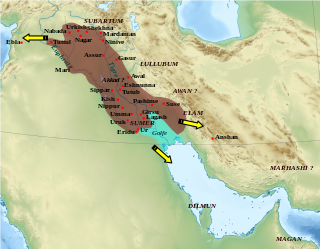
The Akkadian Empire was the first known ancient empire of Mesopotamia, succeeding the long-lived civilization of Sumer. Centered on the city of Akkad and its surrounding region, the empire united Akkadian and Sumerian speakers under one rule and exercised significant influence across Mesopotamia, the Levant, and Anatolia, sending military expeditions as far south as Dilmun and Magan in the Arabian Peninsula.

Sumer is the earliest known civilization, located in the historical region of southern Mesopotamia, emerging during the Chalcolithic and early Bronze Ages between the sixth and fifth millennium BC. Like nearby Elam, it is one of the cradles of civilization, along with Egypt, the Indus Valley, the Erligang culture of the Yellow River valley, Caral-Supe, the Cucuteni–Trypillia culture of the Carpathian Mountains, and Mesoamerica. Living along the valleys of the Tigris and Euphrates rivers, Sumerian farmers grew an abundance of grain and other crops, a surplus which enabled them to form urban settlements. The world's earliest known texts come from the Sumerian cities of Uruk and Jemdet Nasr, and date to between c. 3350 – c. 2500 BC, following a period of proto-writing c. 4000 – c. 2500 BC.
Uruk, known today as Warka, was an ancient city in the Near East, located east of the current bed of the Euphrates River, on an ancient, now-dried channel of the river. The site lies 93 kilometers northwest of ancient Ur, 108 kilometers southeast of ancient Nippur, and 24 kilometers southeast of ancient Larsa. It is 30 km (19 mi) east of modern Samawah, Al-Muthannā, Iraq.
Lagash was an ancient city-state located northwest of the junction of the Euphrates and Tigris rivers and east of Uruk, about 22 kilometres (14 mi) east of the modern town of Al-Shatrah, Iraq. Lagash was one of the oldest cities of the Ancient Near East. The ancient site of Nina is around 10 km (6.2 mi) away and marks the southern limit of the state. Nearby Girsu, about 25 km (16 mi) northwest of Lagash, was the religious center of the Lagash state. The Lagash state's main temple was the E-ninnu at Girsu, dedicated to the god Ningirsu. The Lagash state incorporated the ancient cities of Lagash, Girsu, Nina.
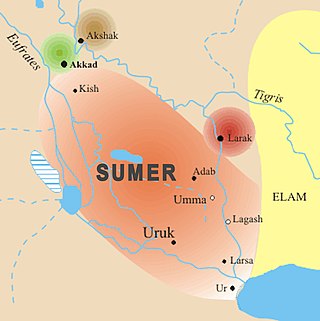
Umma (Sumerian: 𒄑𒆵𒆠ummaKI; in modern Dhi Qar Province in Iraq, was an ancient city in Sumer. There is some scholarly debate about the Sumerian and Akkadian names for this site. Traditionally, Umma was identified with Tell Jokha. More recently it has been suggested that it was located at Umm al-Aqarib, less than 7 km to its northwest or was even the name of both cities. One or both were the leading city of the Early Dynastic kingdom of Gišša, with the most recent excavators putting forth that Umm al-Aqarib was prominent in EDIII but Jokha rose to preeminence later. The town of KI.AN was also nearby. KI.AN, which was destroyed by Rimush, a ruler of the Akkadian Empire. There are known to have been six gods of KI.AN including Gula KI.AN and Sara KI.AN.
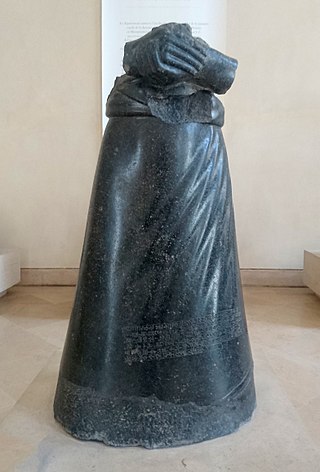
Manishtushu (Man-ištušu) c. 2270-2255 BC was the third king of the Akkadian Empire, reigning 15 years from c. 2270 BC until his death in c. 2255 BC. His name means "Who is with him?". He was the son of Sargon the Great, the founder of the Akkadian Empire, and he was succeeded by his son, Naram-Sin who also deified him posthumously. A cylinder seal, of unknown provenance, clearly from the reign of Naram-Sin or later, refers to the deified Manishtushu i.e. "(For) the divine Man-istusu: Taribu, the wife of Lugal-ezen, had fashioned". Texts from the later Ur III period show offerings to the deified Manishtushu. The same texts mention a town of ᵈMa-an-iš-ti₂-su where there was a temple of Manishtushu. This temple was known in the Sargonic period as Ma-an-iš-t[i-s]uki.

Shar-Kali-Sharri reigned c. 2217–2193 BC as the ruler of the Akkadian Empire. In the early days of cuneiform scholarship the name was transcribed as "Shar-Gani-sharri". In the 1870s, Assyriologists thought Shar-Kali-Sharri was identical with the Sargon of Akkad, first ruler of the Akkadian Empire, but this identification was recognized as mistaken in the 1910s. His name was sometimes written with the leading Dingir sign demarking deification and sometimes without it. Clearly at some point he was deified and two of his designations marked his divine status, "heroic god of Akkade", and "god of the land of Warium". He was the son and successor of Naram-Sin who deified himself during his lifetime.

Naram-Sin, also transcribed Narām-Sîn or Naram-Suen, was a ruler of the Akkadian Empire, who reigned c. 2254–2218 BC, and was the third successor and grandson of King Sargon of Akkad. Under Naram-Sin the empire reached its maximum extent. He was the first Mesopotamian king known to have claimed divinity for himself, taking the title "God of Akkad", and the first to claim the title "King of the Four Quarters". He became the patron city god of Akkade as Enlil was in Nippur. His enduring fame resulted in later rulers, Naram-Sin of Eshnunna and Naram-Sin of Assyria as well as Naram-Sin of Uruk, assuming the name.

Lugal-Zage-Si of Umma was the last Sumerian king before the conquest of Sumer by Sargon of Akkad and the rise of the Akkadian Empire, and was considered as the only king of the third dynasty of Uruk, according to the Sumerian King List. Initially, as king of Umma, he led the final victory of Umma in the generation-long conflict with the city-state Lagash for the fertile plain of Gu-Edin. Following up on this success, he then united Sumer briefly as a single kingdom.

A kudurru was a type of stone document used as a boundary stone and as a record of land grants to vassals by the Kassites and later dynasties in ancient Babylonia between the 16th and 7th centuries BC. The original kudurru would typically be stored in a temple while the person granted the land would be given a clay copy to use to confirm legal ownership. Kudurrus are often linked to what are usually called "ancient kudurrus", land grant stones from the third millennium which serve a similar purpose though the word kudurru did not emerge until the 2nd millennium.

The Warka Vase or Uruk vase is a slim carved alabaster vessel found in the temple complex of the Sumerian goddess Inanna in the ruins of the ancient city of Uruk, located in the modern Al Muthanna Governorate, in southern Iraq. Like the Uruk Trough and the Narmer Palette from Egypt, it is one of the earliest surviving works of narrative relief sculpture, dated to c. 3200–3000 BC. Simple relief sculpture is also known from much earlier periods, from the site of Göbekli Tepe, dating to circa 9000 BC.

Meli-Šipak II, or alternatively Melišiḫu in contemporary inscriptions, was the 33rd king of the Kassite or 3rd Dynasty of Babylon c. 1186–1172 BC and ruled for 15 years. Tablets with two of his year names, 4 and 10, were found at Ur. His reign marks the critical synchronization point in the chronology of the Ancient Near East.

Entemena, also called Enmetena, lived circa 2400 BC, was a son of Enannatum I who he re-established Lagash as a power in Sumer. He defeated Il, king of Umma, in a territorial conflict through an alliance with Lugal-kinishe-dudu of Uruk, successor to Enshakushanna, who is in the king list. The tutelary deity Shul-utula was his personal deity. His reign lasted at least 19 years.

Rimush c. 2279–2270 BC was the second king of the Akkadian Empire. He was the son of Sargon of Akkad and Queen Tashlultum. He was succeeded by his brother Manishtushu, and was an uncle of Naram-Sin of Akkad. Naram-Sin posthumously deified Sargon and Manishtushi but not his uncle. His sister was Enheduana, considered the earliest known named author in world history. Little is known about his brother Shu-Enlil. There was a city, Dur-Rimuš, located near Tell Ishchali and Khafajah. It was known to be a cult center of the storm god Adad.
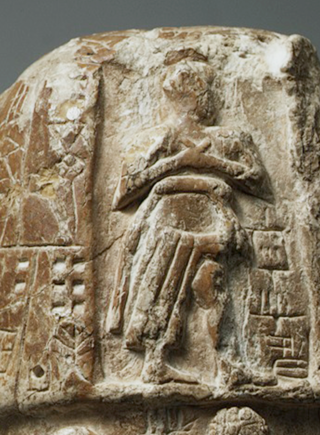
Aga commonly known as Aga of Kish, was the twenty-third and last king in the first dynasty of Kish during the Early Dynastic I period. He is listed in the Sumerian King List and many sources as the son of Enmebaragesi. The Kishite king ruled the city at its peak, probably reaching beyond the territory of Kish, including Umma and Zabala.
Tell Uqair is a tell or settlement mound northeast of ancient Babylon, about 25 kilometers north-northeast of the ancient city of Kish, just north of Kutha, and about 50 miles (80 km) south of Baghdad in modern Babil Governorate, Iraq. It was occupied in the Ubaid period and the Uruk period. It has been proposed as the site of the 3rd millennium BC city of Urum.
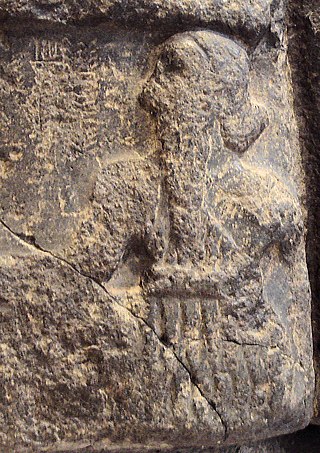
Sargon of Akkad, also known as Sargon the Great, was the first ruler of the Akkadian Empire, known for his conquests of the Sumerian city-states in the 24th to 23rd centuries BC. He is sometimes identified as the first person in recorded history to rule over an empire.
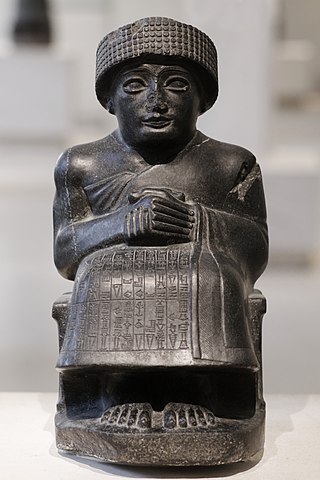
The art of Mesopotamia has survived in the record from early hunter-gatherer societies on to the Bronze Age cultures of the Sumerian, Akkadian, Babylonian and Assyrian empires. These empires were later replaced in the Iron Age by the Neo-Assyrian and Neo-Babylonian empires. Widely considered to be the cradle of civilization, Mesopotamia brought significant cultural developments, including the oldest examples of writing.
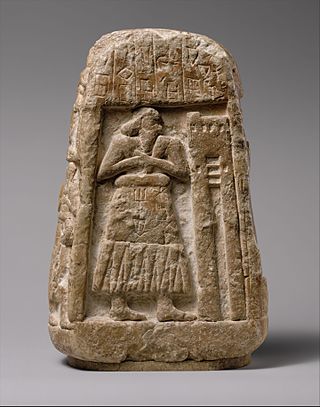
The Stele of Ushumgal is an early Sumerian stone tablet, dating to the Early Dynastic I-II, and probably originating from Umma. It is currently located in the Metropolitan Museum of Art, New York.
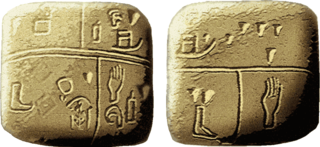
The proto-cuneiform script was a system of proto-writing that emerged in Mesopotamia, eventually developing into the early cuneiform script used in the region's Early Dynastic I period. It arose from the token-based system that had already been in use across the region in preceding millennia. While it is known definitively that later cuneiform was used to write the Sumerian language, it is still uncertain what the underlying language of proto-cuneiform texts were.























